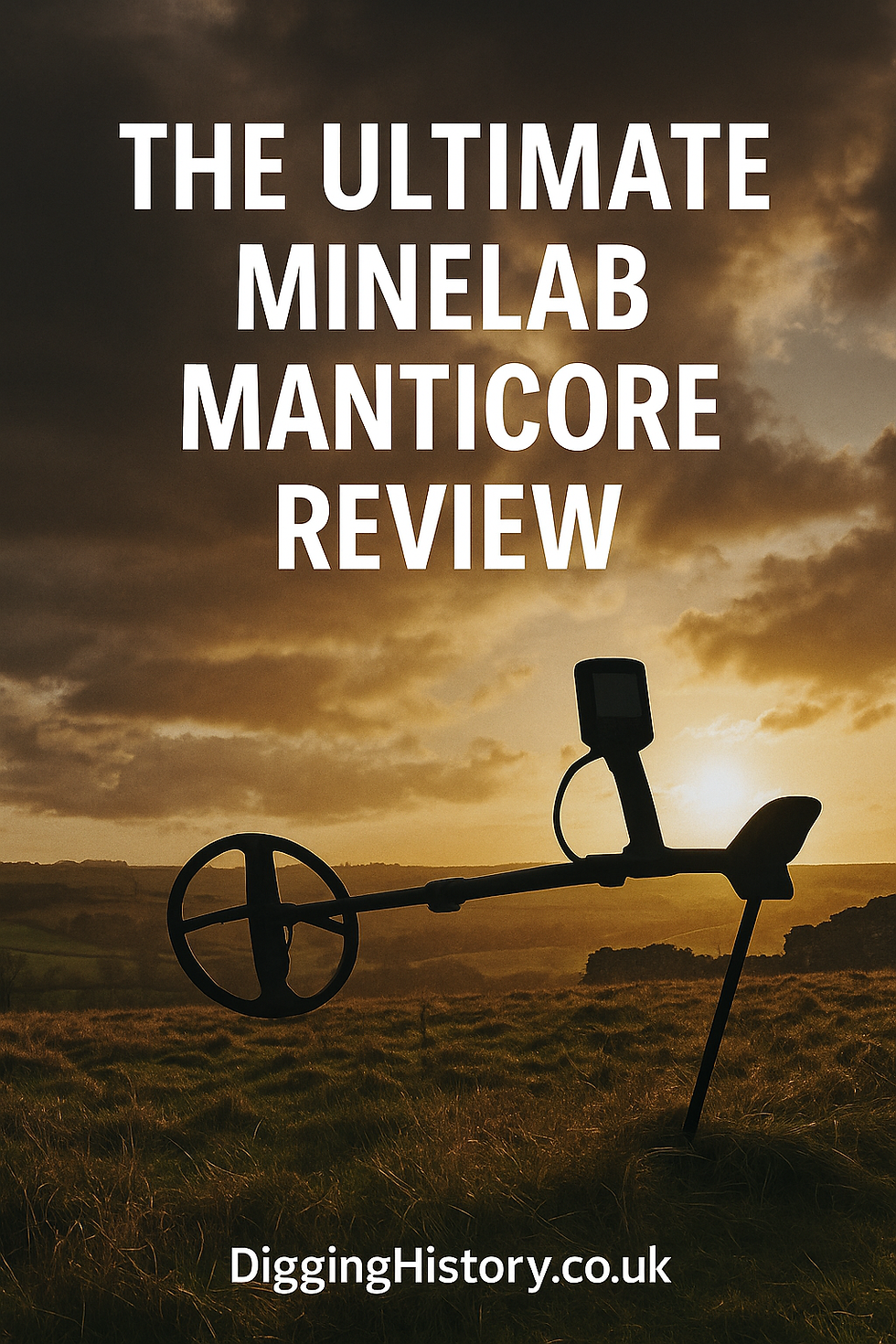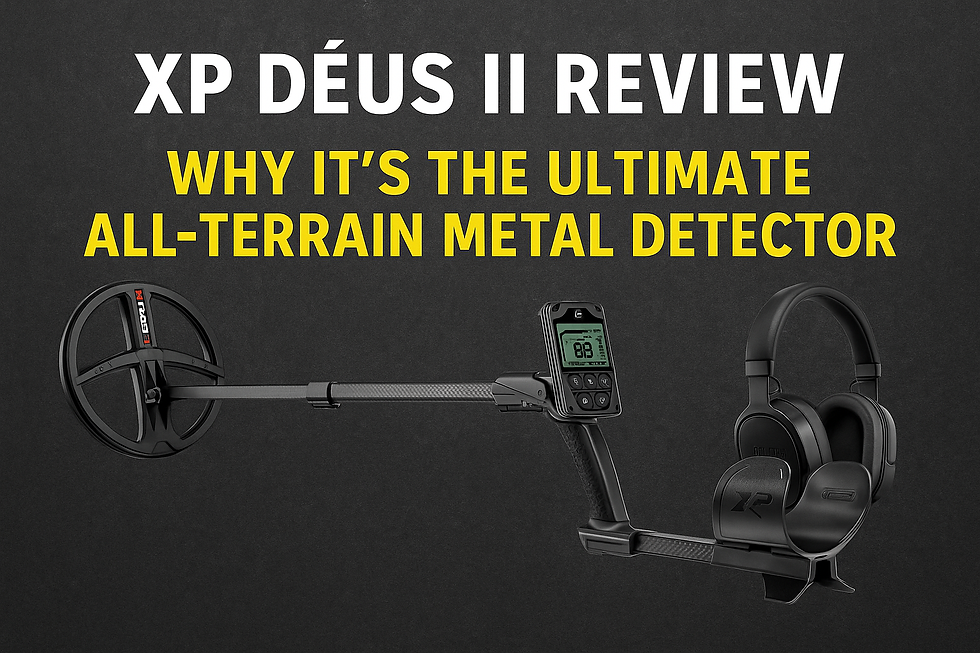How To Choose The Right Metal Detector Coil – Coil Size, Shape, and Depth Explained
- DiggingHistory.co.uk
- Sep 14
- 4 min read
Updated: Sep 22
Every detectorist knows the thrill of hearing that crisp signal in the headphones – the sound that promises something exciting beneath the soil. But what many beginners don’t realise is just how much their search coil affects those signals.
The right coil can mean the difference between finding a hammered penny or missing it entirely. Between digging deep for a Roman brooch or walking past it.
This guide will cover everything you need to know about metal detector coils, size, shape, depth, weight, and technology, so you can make informed choices and improve your success rate across the UK’s varied detecting conditions.

Why the Metal Detector Coil is the Heart of Your Detector
The search coil is often underestimated. While the control box processes signals, it’s the coil that creates the electromagnetic field which “interrogates” the ground.
When metal disrupts this field, the detector responds. The bigger, smaller, rounder, or narrower your coil is, the more it changes how those signals appear.
Detectorists sometimes call the coil the “business end” of the detector – and with good reason.
A small coil can pick coins from iron-laden medieval sites.
A large coil can pull relics from deep below Lincolnshire fields.
The wrong coil, however, might only leave you with foil wrappers and bottle tops.
Understanding Coil Sizes
Coils come in different diameters, usually ranging from 4 inches to 15 inches or more. Size has a huge impact on depth, coverage, and target separation.
Small Coils (4–6 inches)
Advantages
Superb in “trashy” areas with lots of iron, foil, or nails.
Excellent target separation – allows you to distinguish signals close together.
Lightweight and perfect for long hunts without fatigue.
Great for finding tiny hammered coins or delicate jewellery.
Disadvantages
Less ground coverage per sweep – slower hunting.
Limited depth, especially for larger objects.
UK Applications
Old house sites littered with iron nails.
Woodland paths.
Narrow riversides or tight spaces.
Medium Coils (7–9 inches)
The most common “stock” size for detectors.
Advantages
Balance of depth and separation.
Comfortable to swing for hours.
Covers more ground than small coils, but without excessive weight.
Disadvantages
Less precision in trashy sites than small coils.
Won’t reach the extreme depths of larger coils.
UK Applications
General farmland detecting.
Beginners starting out.
Detecting across mixed terrain.
Large Coils (10–15 inches and beyond)
Advantages
Maximum depth, especially on larger targets.
Excellent coverage – ideal for open fields or beaches.
Can detect hoards or caches at impressive depths.
Disadvantages
Heavy, can cause fatigue.
Poor separation – may “see” junk and treasure as one target.
Struggles with very small finds (cut halves, tiny hammered coins).
UK Applications
Clean farmland with little modern rubbish.
Open beaches.
Deep relic hunting.
Coil Shapes: Round vs Elliptical
Shape determines how the detection field is distributed.
Round coils
Greater depth.
More stable signals.
Ideal for open farmland.
Elliptical (oval) coils
Better manoeuvrability through stubble, bushes, and uneven terrain.
Improved target separation.
Slightly less depth than round coils.
Many UK detectorists favour elliptical coils on rough or ploughed fields.
Concentric vs Double-D (DD) Coils
Beyond size and shape, coils are wired differently.
Concentric Coils
Detection field shaped like a cone.
Excellent pinpointing accuracy.
Affordable and common on entry-level machines.
Downside: struggles in mineralised soils – such as certain UK beaches.
Double-D (DD) Coils
Detection field shaped like a “blade” running the length of the coil.
Handles mineralisation well.
Excellent for depth and ground coverage.
Downside: harder to pinpoint targets.
For UK soils, DD coils are usually best.
Depth vs Separation
One of the key trade-offs in coil choice is depth vs separation:
Depth: how far into the ground the coil can detect. Larger coils go deeper.
Separation: the ability to distinguish between targets close together. Smaller coils excel here.
Example:
A 13-inch coil on a clean Suffolk field may hit deep Roman bronzes.
A 5-inch coil on a medieval Norfolk site may isolate a hammered coin among nails.
Matching Coil to Detecting Environment
Farmland
Medium or large DD coils for depth.
Small coil if the land is full of iron.
Beaches
Large coil for wet sand and coverage.
Small coil for dry, trash-heavy sand.
Woodland
Elliptical coils handle roots and uneven ground.
Riversides and Streams
Small coils for manoeuvrability and precision.
Ergonomics: Weight Matters
Don’t underestimate coil weight. Even 100–200 grams difference matters after a day in the field.
Lightweight coils = less fatigue.
Carbon shafts or swing harnesses can help with heavier coils.
Always balance comfort against performance.
Aftermarket Coils
Upgrading your coil can feel like buying a new machine. Popular brands include:
Always confirm compatibility with your machine before buying.
Coil Maintenance Tips
Use a coil cover – protects against scratches.
Clean after hunts – salt and soil can corrode.
Avoid cable strain – don’t wrap too tightly.
Store safely – not in damp sheds or hot cars.
FAQs
Does a bigger coil always mean more depth? Not necessarily – soil mineralisation and target size matter.
Are all coils waterproof? No – check specifications before submerging.
Should I upgrade coil or detector first?If you’re happy with your machine, a new coil is a cost-effective upgrade.
Conclusion
The coil is more than just a piece of hardware – it’s the soul of your detector.
Small coils = precision in trashy sites.
Medium coils = versatility.
Large coils = depth and coverage.
Round = depth, elliptical = agility.
DD = best for UK soils.
By matching your coil to your hunting ground, you’ll avoid wasted digs and dramatically improve your success rate.
So next time you’re heading out to a stubble field in Lincolnshire, a sandy beach in Kent, or a woodland track in Wales – remember: the right coil could make the difference between walking past history, and unearthing it.





Comments